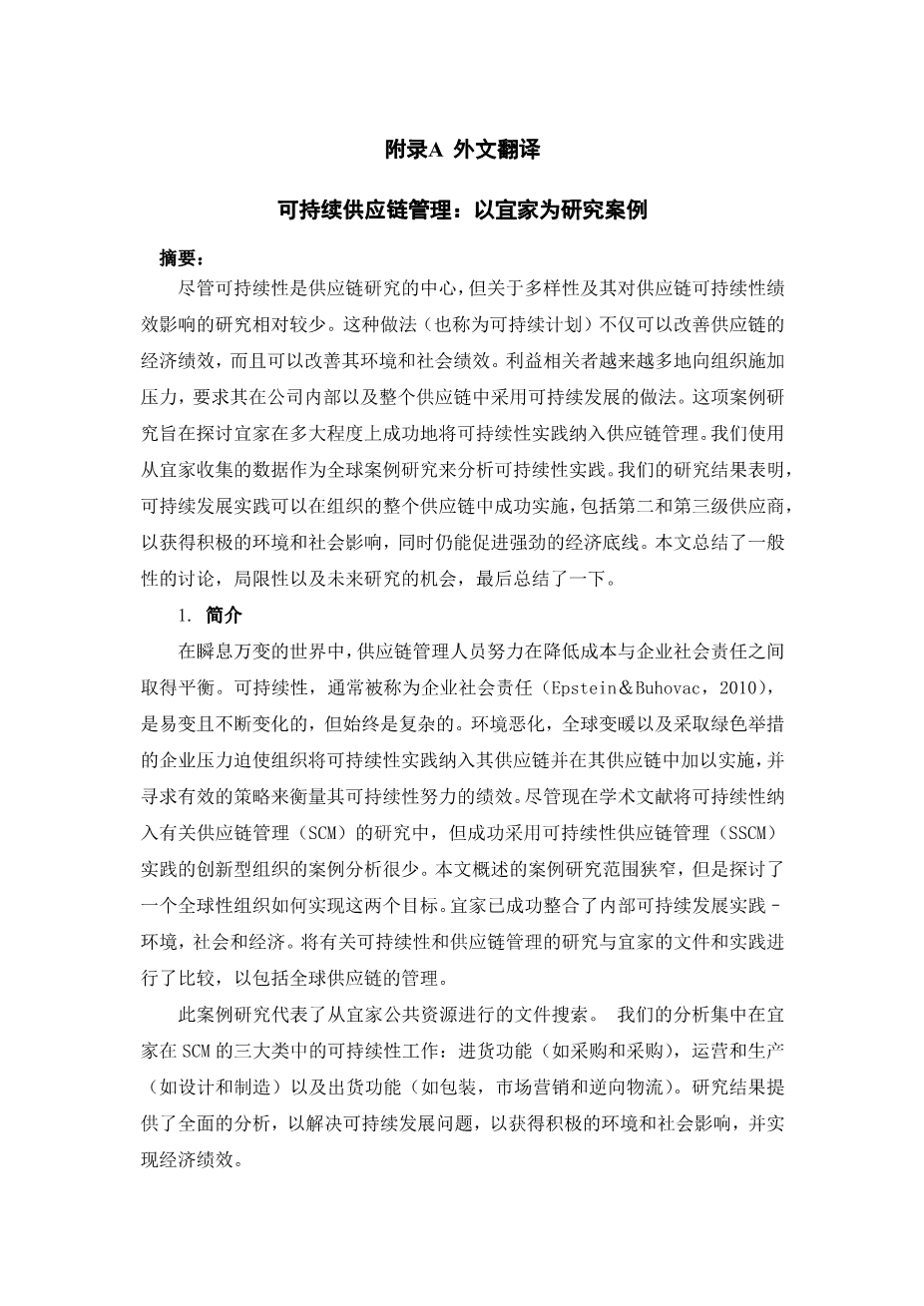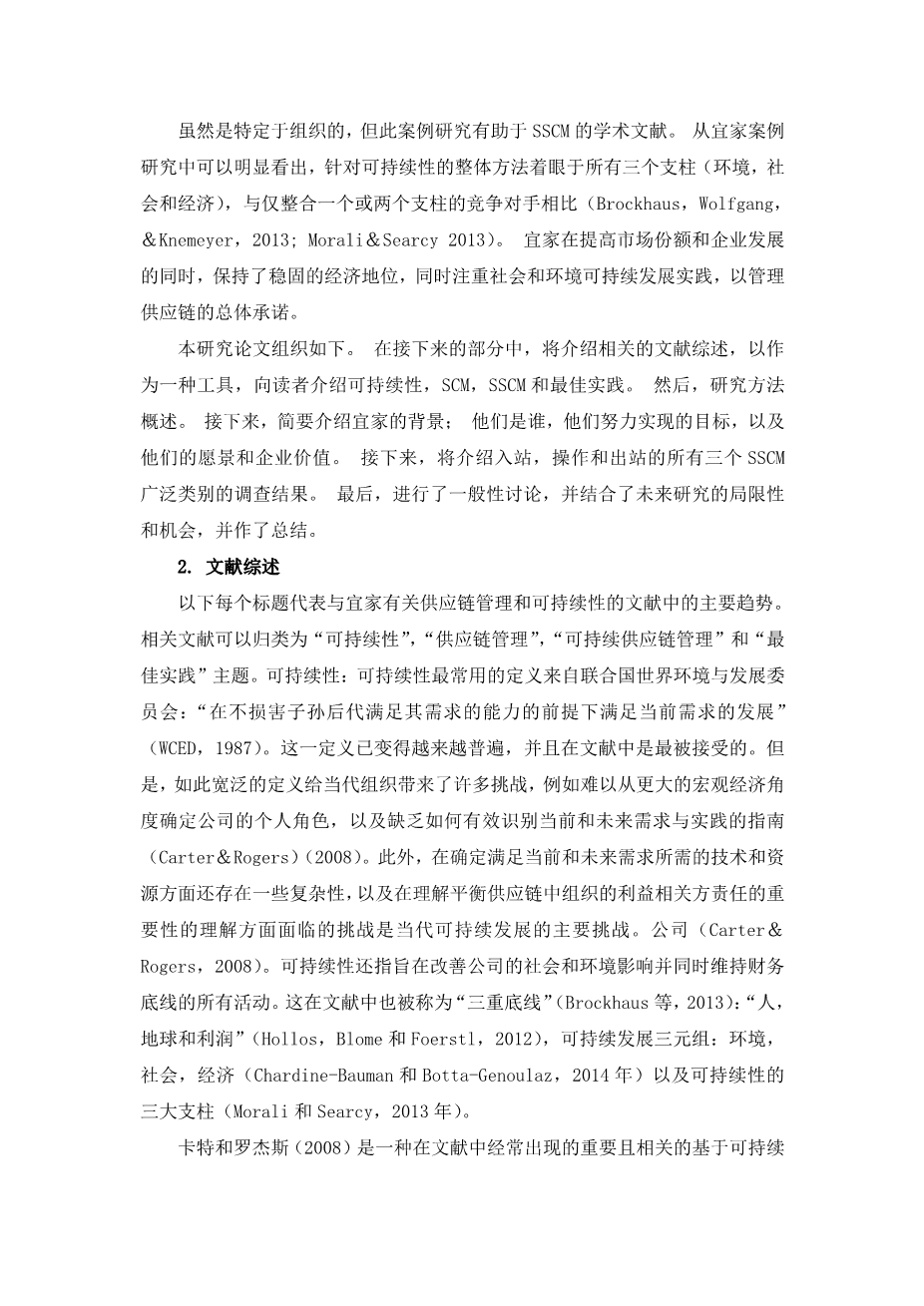附录B 外文原文
Sustainable supply chain management: a case
study at IKEA
ABSTRACT
While sustainability is central to research on supply chains, there has been relatively little research on diversity and impact on supply chain sustainability performance. Such practices, also called sustainable plans, are the ones that improve not only supply chain economic performance, but also their environmental and social performances. Stakeholders are increasingly exerting pressure on organizations to adopt sustainable practices within their firm and across their supply chain. This one case pilot study explores the extent to which IKEA has successfully integrated sustainability practices into the management of the supply chain. We analyse sustainability practices using data gathered from IKEA as a global case study. Our research findings reveal that sustainability practices can be successfully implemented across an organizationrsquo;s entire supply chain, including second and third tier suppliers to gain positive environmental and social impacts while still promoting a strong economic bottom line. The article wraps up with a general discussion, limitations, as well as opportunities for future research, and lastly with concluding remarks.
1. Introduction
In a rapidly changing world, supply chain managers struggle to balance cost reduction with corporate social responsibilities. Sustainability, more commonly known as corporate social responsibility (Epstein amp; Buhovac, 2010), is fluid and ever changing but it is consistently complicated. Environmental degradation, global warming, and cor-porate pressures to adopt green initiatives stress organisations to incorporate and implement sustainability practi-ces into their supply chain, and seek effective strategies to measure the performance of their sustainability efforts. Although scholarly literature now includes sustainability in research about supply chain management (SCM), case analyses of innovative organisations successfully adopting sustainable supply chain management (SSCM) practices are few. The case study outlined in this paper is narrow, but explores how one global organisation has achieved both of these goals. IKEA has successfully integrated in-house sustainability practices – environmental, social, and economic. Research on sustainability and SCM compared against IKEArsquo;s documents and practices to include the management of a global supply chain.
This case study represents document searches from IKEA public sources. Our analysis focussed on IKEArsquo;s sus-tainability efforts within the three broad categories of SCM: inbound functions such as purchasing and procure-ment, operations and production such as design and manufacturing, and outbound functions such as packaging, marketing, and reverse logistics. The research findings provide a comprehensive analysis to address sustainability issues to gain positive environmental and social impacts, and achieve economic performance.
Though organisation specific, this case study contributes to academic literature on SSCM. As evident through the IKEA case study, an holistic approach to sustainability focussing on all three pillars – environmental, social, and economic – will achieve higher economic performance and gain competitive advantage over rival companies that integrate only one or two pillars (Brockhaus, Wolfgang, amp; Knemeyer, 2013; Morali amp; Searcy 2013). While increasing its marketshare and corporate growth IKEA maintained a strong economic position while focussing on an overarching commitment to manage its supply chain by focussing on social and environmental sustainability practices.
This research paper is organised as follows. In the upcoming section, the relevant literature review is presented to serve as a tool to inform the reader on Sustainability, SCM, SSCM, and Best Practices. Then, the research
method is outlined. Next, a brief background on IKEA; who they are, what they strive to accomplish, as well as their vision and corporate values. This is followed by a presentation of findings in all three broad SSCM categories of inbound, operations, and outbound. Lastly, a general discussion piece coupled with limitations and opportuni-ties for future research and concluding remarks.
2. Literature review
Each heading below represents a major trend in the literature relevant to supply chain management and sustain-ability about IKEA. The relevant literature can be categorised under the themes of Sustainability, Supply Chain Management, Sustainable Supply Chain Management, and Best Practices.
Sustainability: The most frequently adopted definition of sustainability comes from the United Nations World Commission on Environment and Development: the lsquo;development that meets the needs of the present without compromising the ability of future generations to meet their needsrsquo; (WCED, 1987). This definition has become increasingly prevalent and is the most accepted one in literature. However, such a broad definition presents many challenges for contemporary organisations such as difficulties in identifying a companyrsquo;s individual role in the larger macro-economic perspective as well as the lack of guidance on how to effectively identify present and future needs and practices (Carter amp; Rogers, 2008). Additionally, there are complications in identifying the technol-ogies and resources necessary to meet those present and future needs as well as challenges in developing an understanding of the importance of balancing an organisationrsquo;s stakeholder responsibilities within the supply chain represent the primary challenges of sustainability for contemporary corporations (Carter amp; Rogers, 2008).
Sustainability also refers to all activities aimed at improving the social and environmental impacts of a com-pany
剩余内容已隐藏,支付完成后下载完整资料


英语译文共 14 页,剩余内容已隐藏,支付完成后下载完整资料
资料编号:[412565],资料为PDF文档或Word文档,PDF文档可免费转换为Word
以上是毕业论文外文翻译,课题毕业论文、任务书、文献综述、开题报告、程序设计、图纸设计等资料可联系客服协助查找。


